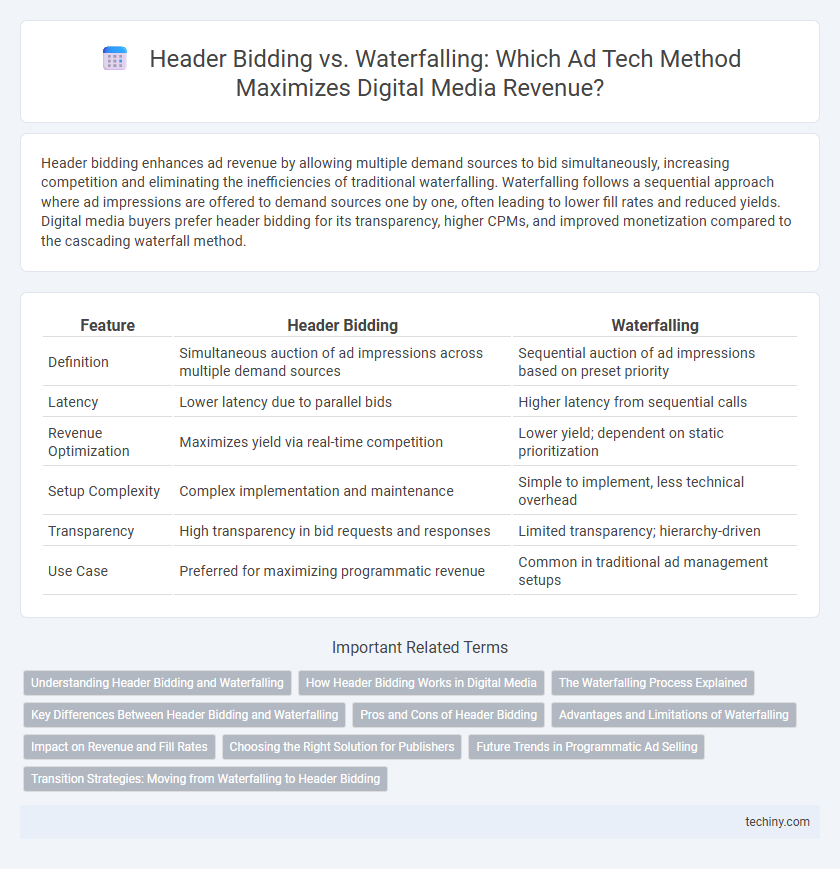Header bidding enhances ad revenue by allowing multiple demand sources to bid simultaneously, increasing competition and eliminating the inefficiencies of traditional waterfalling. Waterfalling follows a sequential approach where ad impressions are offered to demand sources one by one, often leading to lower fill rates and reduced yields. Digital media buyers prefer header bidding for its transparency, higher CPMs, and improved monetization compared to the cascading waterfall method.
Table of Comparison
| Feature | Header Bidding | Waterfalling |
|---|---|---|
| Definition | Simultaneous auction of ad impressions across multiple demand sources | Sequential auction of ad impressions based on preset priority |
| Latency | Lower latency due to parallel bids | Higher latency from sequential calls |
| Revenue Optimization | Maximizes yield via real-time competition | Lower yield; dependent on static prioritization |
| Setup Complexity | Complex implementation and maintenance | Simple to implement, less technical overhead |
| Transparency | High transparency in bid requests and responses | Limited transparency; hierarchy-driven |
| Use Case | Preferred for maximizing programmatic revenue | Common in traditional ad management setups |
Understanding Header Bidding and Waterfalling
Header bidding is an advanced programmatic technique enabling publishers to offer inventory to multiple demand sources simultaneously, increasing competition and maximizing ad revenue. Waterfalling, also known as daisy chaining, involves sequentially offering ad inventory to demand partners based on a prioritized order, often leading to lower yield due to restricted competition. Understanding these methods is crucial for optimizing digital media monetization strategies and improving overall ad performance.
How Header Bidding Works in Digital Media
Header bidding enhances digital media monetization by allowing multiple advertisers to bid simultaneously on ad inventory before the publisher's ad server makes a decision. This real-time auction takes place in the user's browser through a script embedded in the webpage header, increasing competition and maximizing ad revenue. By enabling parallel bids, header bidding reduces latency and prevents revenue loss caused by traditional waterfalling methods.
The Waterfalling Process Explained
The waterfalling process in digital media is a sequential ad inventory management method where ad impressions are offered to demand sources one at a time based on a fixed priority list. Each demand partner is given the opportunity to bid on the inventory until a winning bid is accepted, ensuring the highest priority partner fills the impression before moving to the next. This method often results in slower auction times and potentially lower yield due to less competition among bidders compared to header bidding.
Key Differences Between Header Bidding and Waterfalling
Header bidding allows multiple demand sources to bid simultaneously on ad inventory, maximizing competition and increasing revenue potential for publishers. Waterfalling follows a sequential bidding process where demand sources are ranked and called one after another until a winning bid is found, often limiting competition and revenue. Header bidding improves transparency and fill rates compared to waterfalling's more opaque and less efficient allocation method.
Pros and Cons of Header Bidding
Header bidding increases ad revenue by allowing multiple demand sources to bid simultaneously, leading to higher competition and better CPMs in digital media. This method reduces latency and improves transparency compared to waterfalling, which relies on sequential auctioning and often results in lower fill rates and diminished yield. However, header bidding can introduce complexity in implementation and increase page load times if not optimized properly.
Advantages and Limitations of Waterfalling
Waterfalling in digital media offers simplicity and straightforward implementation by sequentially prioritizing ad networks based on historical performance, enabling predictable revenue streams for publishers. Limitations include lower competition among advertisers and reduced yield optimization, as it forces a rigid order that can lead to unsold inventory despite potentially higher bids later in the sequence. This approach contrasts with header bidding, which enhances real-time competition and maximizes revenue by allowing simultaneous bids from multiple demand sources.
Impact on Revenue and Fill Rates
Header bidding significantly increases publisher revenue and fill rates by allowing multiple demand sources to compete simultaneously for ad inventory, leading to higher bids and reduced latency. In contrast, waterfalling sequentially offers inventory to demand partners, often resulting in lower fill rates and missed revenue opportunities due to less competitive pricing. Data shows that header bidding can boost revenue by up to 40% and improve fill rates by 15%, making it the preferred method for maximizing ad performance.
Choosing the Right Solution for Publishers
Selecting the optimal solution between header bidding and waterfalling is crucial for publishers aiming to maximize ad revenue and optimize user experience. Header bidding offers increased competition by allowing multiple demand partners to bid simultaneously, resulting in higher yield and reduced latency compared to the traditional sequential waterfalling method. Publishers must evaluate factors such as site complexity, traffic volume, and technical resources to determine whether the real-time bid auction of header bidding or the simpler setup of waterfalling best aligns with their monetization goals.
Future Trends in Programmatic Ad Selling
Header bidding is rapidly evolving with increased adoption of server-to-server solutions that minimize latency and improve bid transparency compared to traditional waterfalling methods. Future trends in programmatic ad selling emphasize AI-driven optimization and real-time data integration to maximize yield across multiple demand sources. Enhanced machine learning algorithms enable publishers to dynamically adjust auction parameters, driving higher CPMs and better user experience in header bidding environments.
Transition Strategies: Moving from Waterfalling to Header Bidding
Transitioning from waterfalling to header bidding involves integrating client-side or server-side header bidding wrappers to simultaneously request bids from multiple demand partners, enhancing competition and increasing ad revenue. Key strategies include phased implementation, starting with high-value placements, rigorous testing to ensure page performance remains optimal, and continuous monitoring of bid responses to fine-tune the configuration. Emphasizing transparent data flow and real-time analytics enables publishers to optimize yield while minimizing latency compared to the traditional sequential waterfall approach.
Header Bidding vs Waterfalling Infographic

 techiny.com
techiny.com